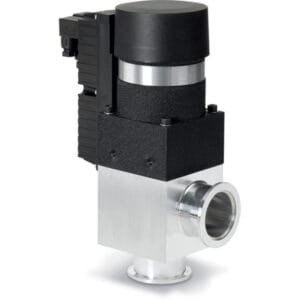Fixed Bored 316LN SS Standard ConFlat® (CF) UHV Flanges
Fixed Bored 316LN SS Standard ConFlat® (CF) UHV Flanges are highly specialized components designed to ensure a strong and reliable connection in ultra-high vacuum (UHV) systems. Made from 316LN stainless steel, these flanges are well-suited for demanding environments that require stable vacuum conditions and minimal outgassing. They are primarily used in industries such as semiconductor manufacturing, research, and material science, where precision and reliability are crucial.
Key Features
Material: Constructed from 316LN stainless steel, a high-grade material known for its outstanding resistance to corrosion, excellent mechanical properties, and low outgassing. These characteristics are essential in UHV applications where contamination and leaks must be minimized.
Fixed Bored Design: The flange comes with a fixed bored hole, making it ideal for situations where precise alignment is critical. Once installed, the flange cannot be rotated, ensuring a secure and stable connection without the need for adjustments.
ConFlat® Seal: The ConFlat® (CF) seal provides a metal-to-metal interface, ensuring a vacuum-tight seal that is both durable and reliable in maintaining ultra-high vacuum conditions.
Standard Dimensions: The flange conforms to the standard ConFlat® (CF) flange dimensions, allowing it to be easily integrated into existing vacuum systems that use CF components.
High Purity and Durability: The 316LN stainless steel material ensures the flange has exceptional purity, high strength, and corrosion resistance, making it suitable for long-term use in demanding applications.
Reliable Performance: The fixed bored design helps maintain consistent alignment and minimizes the risk of misalignment or shifting during operation.
Applications
Ultra-High Vacuum Systems: Ideal for use in UHV applications, such as in semiconductor processing, electron microscopy, and material deposition, where maintaining a clean, stable, and high-quality vacuum environment is crucial.
Semiconductor Manufacturing: Widely used in semiconductor processing equipment for thin-film deposition, etching, and other critical processes that require precise vacuum control and contamination-free conditions.
Research Laboratories: Essential for high-energy physics experiments, vacuum chambers, and other research environments where ultra-high vacuum is required for controlled testing and analysis.
Material Science: Used in material testing and thin-film deposition systems where precise vacuum conditions are necessary to ensure the quality and integrity of the materials being tested or created.
Vacuum Furnace Systems: Suitable for use in vacuum furnaces, which require a sealed environment for high-temperature material processing or sintering.
Why Choose TFM’s Fixed Bored 316LN SS Standard ConFlat® (CF) UHV Flanges?
Superior Material: 316LN stainless steel ensures outstanding corrosion resistance and low outgassing, which is essential for maintaining the integrity of UHV systems.
Fixed Design: The fixed bored design ensures precise alignment and eliminates the need for rotational adjustments, making it ideal for applications where stable connections and fixed alignment are required.
Leak-Tight Sealing: The ConFlat® metal-to-metal seal provides a robust, leak-tight connection, ensuring that the vacuum system maintains its integrity during operation.
Compatibility with CF Components: These flanges conform to ConFlat® dimensions, ensuring compatibility with a wide range of CF components, making them easy to integrate into existing vacuum systems.
Customizable: Available in a variety of sizes and configurations to meet the specific requirements of different applications, whether in research, semiconductor, or industrial environments.
Long-Term Durability: Made from high-quality stainless steel and processed for high-density and uniformity, these flanges are designed to last and provide reliable performance over an extended period.
Manufacturing Process
Cold Pressing and Sintering: The flanges are manufactured using cold pressing and sintering techniques, resulting in dense, uniform components that offer excellent performance in vacuum applications.
Elastomer Bonding: Each flange is elastomer-bonded to a backing plate, ensuring enhanced durability and strength, especially under UHV conditions.
Thorough Cleaning: The flanges are thoroughly cleaned to remove any contaminants that might affect vacuum performance, ensuring they are ready for use in sensitive applications.
Protective Packaging: To prevent damage or contamination during shipping, the flanges are carefully packaged and sealed to maintain their integrity upon delivery.
Ordering Table
| Flange Size/OD | Type | Note | Part Number |
| DN16CF (1.33" OD) | Fixed | — | F0133N075NLN |
| DN25CF (2.13" OD) | Fixed | — | F0212N100NLN |
| DN35CF-DN40CF (2.75" OD) | Fixed | — | F0275N100NLN |
| DN35CF-DN40CF (2.75" OD) | Fixed | — | F0275N150NLN |
| DN35CF-DN40CF (2.75" OD) | Fixed | — | F0275N162NLN |
| DN35CF-DN40CF (2.75" OD) | Fixed | — | F0275N175NLN |
| DN50CF (3.38" OD) | Fixed | — | F0337N150NLN |
| DN50CF (3.38" OD) | Fixed | — | F0337N200NLN |
| DN63CF (4.50" OD) | Fixed | — | F0450N150NLN |
| DN63CF (4.50" OD) | Fixed | — | F0450N250NLN |
| DN63CF (4.50" OD) | Fixed | — | F0450N275NLN |
| DN75CF (4.63" OD) | Fixed | — | F0462N250NLN |
| DN75CF (4.63" OD) | Fixed | F0462N300NLN | |
| DN75CF (4.63" OD) | Fixed | F0462N300NLN | |
| DN75CF (4.63" OD) | Fixed | F0462N300NLN | |
| DN100CF (6.00" OD) | Fixed | — | F0600N400NLN |
| DN160CF (8.00" OD) | Fixed | — | F0800N600NLN |
| DN160CF (8.00" OD) | Fixed | — | F0800N608NLN |
| DN200CF (10.00" OD) | Fixed | — | F1000N800NLN |
| DN250CF (12.00" OD) | Fixed | — | F1200N1000NLN |
| DN275CF (13.25" OD) | Fixed | — | F1325N1000NLN |
| DN295CF (14.00" OD) | Fixed | F1400N1200NLN |





Reviews
There are no reviews yet.